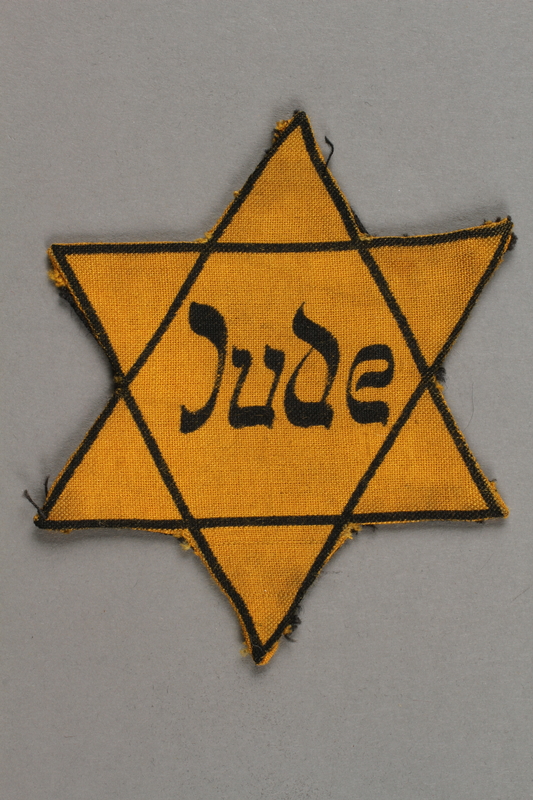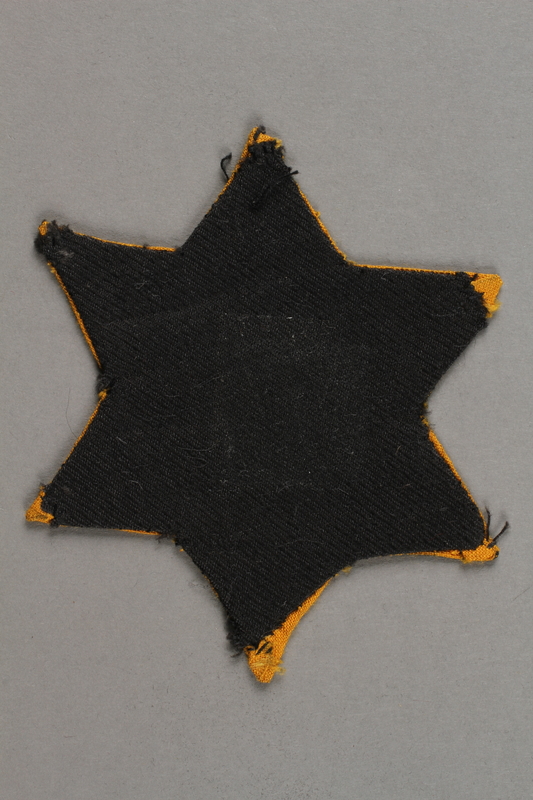Overview
- Brief Narrative
- Yellow cloth Star of David badge worn by Hans Benjamin Marx while living under the Nazi dictatorship in Frankfurt am Main, Germany, between September 1, 1941 and February 14, 1945. All Jews in the Reich were required to wear Judenstern on their outer clothing at all times to identify themselves as Jewish. Hans spent most of the war in Frankfurt with his older sister, Claire, and their mother, Elise. Elise was a Protestant, but converted to Judaism before getting married to Hans’s father, Ernest. In November 1938, following the Kristallnacht pogrom, Ernest was arrested and transported to Buchenwald concentration camp. In December, Ernest was released and promised to leave the country within two weeks. He spent the rest of the war in Egypt. Because Hans was a child from a mixed marriage and classified as Geltungsjude, Jewish by law, he was subject to anti-Jewish restrictions beginning in 1935. After eight years of elementary school, 14-year-old Hans became a carpentry apprentice. In January 1945, Hans turned 18 and could no longer be protected by his mother’s Aryan status. On February 14, 1945, he was deported to Theresienstadt ghetto-labor camp in German-occupied Czechoslovakia. As a forced laborer, Hans helped to build an alleged air raid shelter, and tried to sabotage it. On May 8, 1945, the Red Army liberated the camp. In June, Hans returned to Frankfurt and reunited with his mother and sister. They immigrated to the United States on June 6, 1946, and reunited there with his father in 1947.
- Date
-
use:
after 1941 September 01-before 1945 February 14
- Geography
-
use:
Frankfurt am Main (Germany)
- Credit Line
- United States Holocaust Memorial Museum Collection, Gift of Judith Marx
- Markings
- face, center, printed, black ink: JUDE [Jew]
- Contributor
-
Subject:
Hans B. Marx
- Biography
-
Hans Benjamin Marx (b. 1927) was born in Mannheim, Germany, to Elise (née Rihm, 1898-1976) and Ernest Marx (1895-1965). Ernest was born in Mannheim, and worked as a traveling salesman. Elise was born in Mannheim to Protestant parents, but converted to Orthodox Judaism prior to marrying Ernest. Hans’s had one older sister, Claire (Klara, 1925-2009). The family moved to Frankfurt am Main in the early spring of 1932. Han’s mother wanted to raise her children fully Jewish. Hans’s father, however, was less religiously inclined, resulting in Hans and his sister belonging to an Orthodox congregation while growing up in a home that was not especially observant. They celebrated some Jewish holidays, but did not follow kosher rules. Hans’s father refused to go to the synagogue, and instead of observing the Sabbath the children attended school on Saturdays.
Less than three months after Hitler came to power in January 1933, Hans enrolled in first grade in his neighborhood public school. Following the September 15, 1935, passage of the Nuremberg Laws, Hans and Claire, as offspring of a mixed marriage, were classified as Geltungsjude, Jews by law. In 1938, Jewish children were barred from public schools, and Hans and Claire had to travel nearly an hour by bus and streetcar to get to their new school. On November 9 and 10, during the Kristallnacht pogrom, the family’s synagogue was robbed, along with local Jewish businesses. On November 11, the Gestapo showed up at the Marx house and arrested Hans’s father, Ernest, and then deported him to Buchenwald concentration camp, where he was assigned prisoner number 29361. Hans and his mother and sister were forced out of their house in order to make their neighborhood Judenrein, free of Jews, by the end of the month. They had to sell off most of their costlier furniture and possessions and move into a designated Jewish building. Ernest returned from Buchenwald on December 8. He was released because he had a visa for Switzerland, and promised to leave Germany within two weeks. Ernest left for Switzerland in January 1939, his plan to travel for work in the Middle East and help his family emigrate from Germany. Due to increased war tensions around the world his plans were unsuccessful. Ernest spent the rest of the war in Egypt working for the British intelligence services.
In the spring of 1939, Hans’s mother made arrangements for them all to move into a Jewish boarding house where the children were able to start taking classes again in exchange for her working there. Restrictions against Jews continued to grow, especially after Great Britain and France declared war on Germany following the September 1, 1939 invasion of Poland. The Gestapo confiscated the Marx family’s radio, severely limiting their access to outside news. They were issued ration cards marked with a “J” that could only be used at the special Jewish stores called Juden Laden. Despite increasing restrictions, Hans managed to have his Bar Mitzvah at the Underlindau Schule, an Orthodox synagogue in Frankfurt, in January of 1940. In early 1941, the Nazis ordered all synagogues closed, and outlawed Jewish religious services.
Jewish children were limited to eight years of elementary school, so in 1941, 14-year-old Hans became a carpentry apprentice at the Jewish trade school in Frankfurt, the Anlernwerkstatt. Hans found the work boring, and often got in trouble with the foreman for work interruptions. The Gestapo frequently forced the young Jewish apprentices to carry out tasks for them. The worst assignment for Hans was when the Gestapo ordered the boys to assist the SS in loading the trains in the Grossmarkthalle, wholesale market hall, taking the Jews from Frankfurt to camps.
Following the fourth and final transport from the Grossmarkthalle, the carpentry shop where Hans worked was shut down because there were no longer enough workers. All Jews, between 14 and 65, were still required to work. In the spring of 1942, Hans reported to the Jewish community office in Frankfurt for his work assignment. He was assigned to do maintenance work in city parks, and later work as a street cleaner. In 1942 the Gestapo also assigned Hans and his mother, who now worked at a factory, and sister, who worked at the Jewish community center, to a two bedroom apartment in a Judenhaus or Jew house.
In December 1944, Hans turned 18 and became an adult, so he lost the protection of his mother’s Aryan status. In January 1945, the Reich Main Security Office (RSHA) ruled that members of mixed marriages and persons of mixed “race” should be sent to Theresienstadt ghetto-labor camp for supervised labor. Hans received his deportation order, and on February 14 he reported to the city’s Ostbahnof, East Railroad Station, where he was loaded onto a cattle car bound for Theresienstadt in German-occupied Czechoslovakia. Upon arrival, the SS assigned Hans and other men to forced labor building an alleged air raid shelter. The men often tried to slow progress through subtle forms of sabotage. Hans’s sister, Claire, managed to avoid deportation only because she was part of the small staff that the Gestapo permitted to work at the Jewish Community Center.
Soviet troops entered Theresienstadt on May 8, 1945, officially liberating the camp. At liberation, Hans was suffering from a severe fever, malnutrition, and a damaged lung. At the beginning of June, after increased rations helped him recuperate, he received permission to leave the camp, and a travel pass from a Soviet officer. He found his own way back to Frankfurt, where he reunited with his mother and sister on June 14, 1945. In summer 1946, all three immigrated to the United States aboard the SS Marine Flasher. In 1947, they finally reunited in New York with Hans’s father, Ernest. After serving in the US Army, Hans became a computer scientist. He met and married Norma Shear in 1955 in New York City, where she was born and raised. The couple resettled in Pennsylvania and went on to raise three daughters.
Physical Details
- Language
- German
- Classification
-
Identifying Artifacts
- Category
-
Badges
- Object Type
-
Star of David badges (lcsh)
- Genre/Form
- Magen David.
- Physical Description
- Yellow, cloth badge in the shape of a 6-pointed Star of David. The star outline is formed by two black triangles, printed to overlap one another. In the center is German text in a font resembling Hebrew. The yellow cloth is slightly discolored. Small black threads extend from the top and bottom left points. The black backing cloth is cut unevenly, attached with black thread, and does not fully cover the points, particularly on the bottom point.
- Dimensions
- overall: Height: 3.750 inches (9.525 cm) | Width: 3.250 inches (8.255 cm)
- Materials
- overall : cloth, ink, thread
Rights & Restrictions
- Conditions on Access
- No restrictions on access
- Conditions on Use
- No restrictions on use
Keywords & Subjects
- Topical Term
- Identification (Religion). Star of David badges. Holocaust, Jewish (1939-1945)--Germany--Frankfurt am Main--Personal narratives. Jews--Persecutions--Germany--Frankfurt am Main. Children of interfaith marriage--Germany--Frankfurt am Main--Biography. Forced labor--Germany--Frankfurt am Main--History.
- Geographic Name
- Frankfurt am Main (Germany) Terezín (Ústecký kraj, Czech Republic)
- Corporate Name
- Theresienstadt (Concentration camp)
Administrative Notes
- Legal Status
- Permanent Collection
- Provenance
- The badge was donated to the United States Holocaust Memorial Museum in 2018 by Judith Marx, the daughter of Hans Benjamin Marx.
- Record last modified:
- 2022-08-01 10:55:06
- This page:
- https://collections.ushmm.org/search/catalog/irn633653
Download & Licensing
In-Person Research
- By Appointment
- Request 21 Days in Advance of Visit
- Plan a Research Visit
- Request to See This Object
Contact Us
Also in Hans Benjamin Marx collection
The collection consists of an armband, ghetto scrip, Star of David badges, correspondence, documents, and photographs relating to the experiences of Hans Benjamin Marx and the Marx family in Germany before and during the Holocaust, in Theresienstadt ghetto-labor camp during the Holocaust, and in the United States after World War II.
Date: approximately 1920-2005
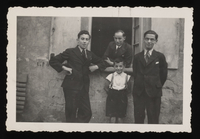
Hans Benjamin Marx papers
Document
The collection documents the Holocaust-era experiences of Hans Benjamin Marx and his family, including their pre-war lives in Mannheim and Frankfurt am Main, Hans's experiences in the Theresienstadt concentration camp, and his immigration to the United States aboard the SS Marine Flasher in 1946. The collection consists of an annotated album assembled by Hans with photographs, a small amount of family correspondence (includes donor-provided translations), identity documents, and Hans's SS Marine Flasher ticket.
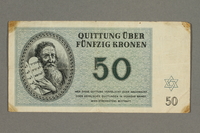
Theresienstadt ghetto-labor camp scrip, 50 kronen note, given to German Jewish prisoner
Object
Scrip, valued at 50 kronen, distributed in Theresienstadt (Terezin) ghetto-labor camp to Hans Benjamin Marx, who was imprisoned at the camp between February 18 and May 8, 1945. At the camp, Hans was issued 50 kronen of ghetto money, which he only used as a deposit when he checked out books from the ghetto library. Hans spent most of the war in Frankfurt with his older sister, Claire, and their mother, Elise. Elise was a Protestant, but converted to Judaism before getting married to Hans’s father, Ernest. In November 1938, following the Kristallnacht pogrom, Ernest was arrested and transported to Buchenwald concentration camp. In December, Ernest was released and promised to leave the country within two weeks. He spent the rest of the war in Egypt. Because Hans was a child from a mixed marriage and classified as Geltungsjude, Jewish by law, he was subject to anti-Jewish restrictions beginning in 1935. After eight years of elementary school, 14-year-old Hans became a carpentry apprentice. In January 1945, Hans turned 18 and could no longer be protected by his mother’s Aryan status. On February 14, 1945, he was deported to Theresienstadt ghetto-labor camp in German-occupied Czechoslovakia. As a forced laborer, Hans helped to build an alleged air raid shelter, and tried to sabotage it. On May 8, 1945, the Red Army liberated the camp. In June, Hans returned to Frankfurt and reunited with his mother and sister. They immigrated to the United States on June 6, 1946, and reunited there with his father in 1947.
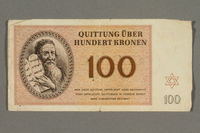
Theresienstadt ghetto-labor camp scrip, 100 kronen note, given to German Jewish prisoner
Object
Scrip, valued at 100 kronen, distributed in Theresienstadt (Terezin) ghetto-labor camp to Hans Benjamin Marx, who was imprisoned at the camp between February 18 and May 8, 1945. At the camp, Hans was issued 50 kronen of ghetto money, which he only used as a deposit when he checked out books from the ghetto library. Hans spent most of the war in Frankfurt with his older sister, Claire, and their mother, Elise. Elise was a Protestant, but converted to Judaism before getting married to Hans’s father, Ernest. In November 1938, following the Kristallnacht pogrom, Ernest was arrested and transported to Buchenwald concentration camp. In December, Ernest was released and promised to leave the country within two weeks. He spent the rest of the war in Egypt. Because Hans was a child from a mixed marriage and classified as Geltungsjude, Jewish by law, he was subject to anti-Jewish restrictions beginning in 1935. After eight years of elementary school, 14-year-old Hans became a carpentry apprentice. In January 1945, Hans turned 18 and could no longer be protected by his mother’s Aryan status. On February 14, 1945, he was deported to Theresienstadt ghetto-labor camp in German-occupied Czechoslovakia. As a forced laborer, Hans helped to build an alleged air raid shelter, and tried to sabotage it. On May 8, 1945, the Red Army liberated the camp. In June, Hans returned to Frankfurt and reunited with his mother and sister. They immigrated to the United States on June 6, 1946, and reunited there with his father in 1947.
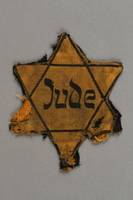
Factory-printed Star of David badge printed with Jude, worn by a German Jewish prisoner
Object
Yellow cloth Star of David badge worn by Hans Benjamin Marx while he was confined at Theresienstadt (Terezin) ghetto-labor camp between February 18 and May 8, 1945. All Jews in the Reich were required to wear Judenstern on their outer clothing at all times to identify themselves as Jewish. Hans spent most of the war in Frankfurt with his older sister, Claire, and their mother, Elise. Elise was a Protestant, but converted to Judaism before getting married to Hans’s father, Ernest. In November 1938, following the Kristallnacht pogrom, Ernest was arrested and transported to Buchenwald concentration camp. In December, Ernest was released and promised to leave the country within two weeks. He spent the rest of the war in Egypt. Because Hans was a child from a mixed marriage and classified as Geltungsjude, Jewish by law, he was subject to anti-Jewish restrictions beginning in 1935. After eight years of elementary school, 14-year-old Hans became a carpentry apprentice. In January 1945, Hans turned 18 and could no longer be protected by his mother’s Aryan status. On February 14, 1945, he was deported to Theresienstadt ghetto-labor camp in German-occupied Czechoslovakia. As a forced laborer, Hans helped to build an alleged air raid shelter, and tried to sabotage it. On May 8, 1945, the Red Army liberated the camp. In June, Hans returned to Frankfurt and reunited with his mother and sister. They immigrated to the United States on June 6, 1946, and reunited there with his father in 1947.
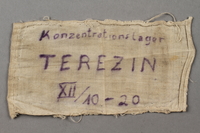
Theresienstadt armband with prisoner number worn by a liberated German Jewish prisoner
Object
Theresienstadt armband worn by Hans Benjamin Marx after liberation in Theresienstadt ghetto-labor camp and on his journey home between May 8 and June 14, 1945. The Soviet commander in charge of the liberated camp prohibited Judenstern, and instead authorized the released prisoners to wear an armband with their transport number on it. Hans spent most of the war in Frankfurt with his older sister, Claire, and their mother, Elise. Elise was a Protestant, but converted to Judaism before getting married to Hans’s father, Ernest. In November 1938, following the Kristallnacht pogrom, Ernest was arrested and transported to Buchenwald concentration camp. In December, Ernest was released and promised to leave the country within two weeks. He spent the rest of the war in Egypt. Because Hans was a child from a mixed marriage and classified as Geltungsjude, Jewish by law, he was subject to anti-Jewish restrictions beginning in 1935. After eight years of elementary school, 14-year-old Hans became a carpentry apprentice. In January 1945, Hans turned 18 and could no longer be protected by his mother’s Aryan status. On February 14, 1945, he was deported to Theresienstadt ghetto-labor camp in German-occupied Czechoslovakia. As a forced laborer, Hans helped to build an alleged air raid shelter, and tried to sabotage it. On May 8, 1945, the Red Army liberated the camp. In June, Hans returned to Frankfurt and reunited with his mother and sister. They immigrated to the United States on June 6, 1946, and reunited there with his father in 1947.

